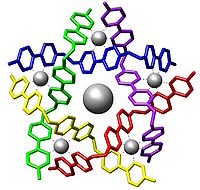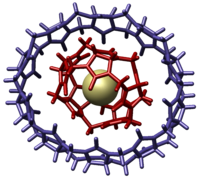Our website is made possible by displaying online advertisements to our visitors.
Please consider supporting us by disabling your ad blocker.
Supramolecular chemistry






Supramolecular chemistry is area of chemistry that studies the relationship and linking molecules into bigger systems. It focuses on the chemical systems made up of a discrete number of assembled molecular subunits or components.[2][3][4] The study of non-covalent interactions is crucial to understanding many biological processes from cell structure to vision that rely on these forces for structure and function. Biological systems are often the inspiration for supramolecular research.
- ↑ Hasenknopf, Bernold; Lehn, Jean-Marie; Kneisel, Boris O.; Baum, Gerhard; Fenske, Dieter (1996). "Self-Assembly of a Circular Double Helicate". Angewandte Chemie International Edition in English. 35 (16): 1838. doi:10.1002/anie.199618381.
- ↑ Lehn JM (1993). "Supramolecular chemistry". Science. 260 (5115): 1762–3. Bibcode:1993Sci...260.1762L. doi:10.1126/science.8511582. PMID 8511582.
- ↑ Supramolecular Chemistry, J.-M. Lehn, Wiley-VCH (1995) ISBN 978-3527293117
- ↑ Gennady V. Oshovsky, David N. Reinhoudt, Willem Verboom (2007). "Supramolecular Chemistry in Water" (PDF). Angewandte Chemie International Edition. 46 (14): 2366–2393. doi:10.1002/anie.200602815. PMID 17370285. S2CID 5969241. Archived from the original (PDF) on 2023-08-29. Retrieved 2023-10-10.
{{cite journal}}: CS1 maint: multiple names: authors list (link)
Previous Page Next Page


